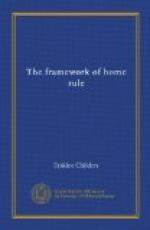From this moment the three Canadas gain sharp definition. To the west Upper Canada, exclusively American or, as we must now say, British in character; next to the east, and cutting off its neighbour from the sea, the ancient Province of Lower Canada, predominantly French, with a minority of British traders in the two towns Quebec and Montreal; last of all the Maritime Provinces, small communities with an almost independent history of their own, although, like Upper and Lower Canada, they eventually presented a problem similar fundamentally to the Irish problem on the other side of the Atlantic. Prince Edward Island is the closest parallel, for, besides the Catholic disabilities of 1770, in 1767 the whole of its land had been granted away by ballot in a single day to a handful of absentee English proprietors, who sublet to occupiers without security of tenure, with the result that a land question similar to that of Ireland arose, which inflamed society and retarded the development of the island for a whole century. Ultimately, moreover, statesmen were driven to an even more drastic solution—compulsory and universal State-aided land purchase.[22] Before the period we have now reached, Nova Scotia and Prince Edward Island, which was carved out of it, had been given rude systems of representative Government, and New Brunswick, also at one time a part of Nova Scotia, received a Constitution in 1784.
The great question after the American War was how to govern the two contiguous Provinces of Upper and Lower Canada, the one newly settled by men of British race and Protestant faith, the other also under the British flag, but overwhelmingly French and Catholic, both, in the critical half-century to come, to be reinforced by immigrants from the Old World, and to a large extent from misgoverned Ireland. But let the reader once and for all grasp this point, that, once out of Ireland, there ceases, not immediately, but in course of time, to be any racial or political distinction between the different classes of Irishmen, whose antagonism at home, artificially provoked and fomented by the bad form of government under which they lived, so often made Ireland itself a very hell on earth. I want to dwell on this point in order to avoid confusion when I speak of the bi-racial conditions of Lower Canada and Ireland respectively.
To return to the question of Government. The American Colonies were lost. Here in Canada was an opportunity for a new Imperial policy, better calculated to retain the affections of the colonists. Three distinct problems were involved:
1. Was French or Lower Canada, with its small minority of British, to be given representative Government at all?
2. If so, was it to be left as a separate unit, or was it to be amalgamated in a Union with its neighbour, Upper Canada?
3. Whichever course was taken, what was to be the relation between the Home Government and Canada?




